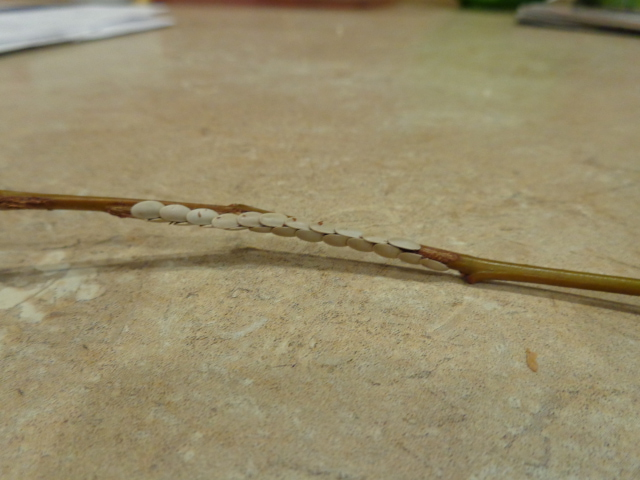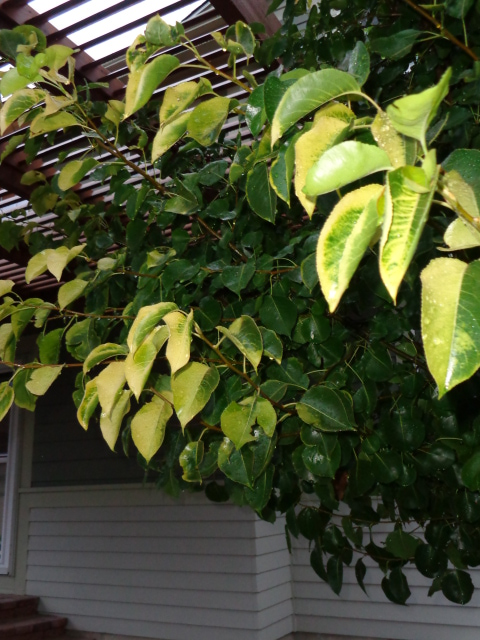Question Scale Shapes
Scale Shapes
 Yellow Color on Leaves
Yellow Color on Leaves
QUESTION: Hello,
I live in Colorado and have a Cleveland Pear that I had planted 3 years ago.
I have what looks like little white oval shapes on a couple of my branches I was hoping you could tell me what it is.
It look like scales.
I attached a couple pictures of it.
Also, last summer (July 2014) one side of the tree, the side that faces south, about 30% of the branches leaves turned yellowish color, not the entire leaf surface.
I attached a couple pictures of that as well.
Thank You for any help you can give.
ANSWER: Dear Steve, First let me apologize for my late response. For some reason, I haven't been getting my questions until they are reported as late. I let the tech people know, so hopefully this problem will be solved soon. Then to answer your questions, it looks like scales, and that is actually what it is, or more accurately, scale, a type of insect which in the adult stage lives unmoving under a hard protective cover. The hard cover, or scale, protects the insect while it sucks all the juices out of your tree. This is undoubtedly why the leaves are also discolored. One of the main problems with scale is that generally, they are not easily killed by conventional insecticides. The hard covering protects the bug from the chemicals. The way to kill them is with a horticultural oil, easily available in gardening centers. Spray the tree completely until it is completely dripping. Get the tops and bottoms of leaves, the stems, everything you can. The oil smothers the insect and makes it impossible for them to breathe, and they will fall off. Now, ideally, you would spray the tree when the temperature is above 80 degrees and sunny. However, you can use a dormant oil (ask for this) and spray the tree, preferably when the wind isn't blowing and the sky is sunny. Your scale will dry up and flake off. You may have to spray once a week for 3 or 4 weeks to be sure you have them all, but this method will work. Afterwards you can begin to fertilize the tree in the spring, but be careful to avoid adding much nitrogen as it causes pear trees to be more susceptible to fire blight, aphids, and of course, scale insects. Fertilizers come with 3 numbers, the first is nitrogen, the second is phosphorus and the third is potassium. Look for combinations that have higher middle and/or last numbers. In other words, choose 5-20-10 over 10-5-5, and so on. I hope this information helps, but be sure to write back if you have further questions, and if any response takes more than 3 days be sure to report it! Good luck, Melissa
---------- FOLLOW-UP ----------
QUESTION: Hi, Melissa.
I need to disagree with the scale. I found on the net the white scale looking items are actually Katydid eggs.
Here is a link to show the picture I originally sent you and the images the web has are identical.
http://www.missouribotanicalgarden.org/gardens-gardening/your-garden/help-for-th
If you do a simple google search for katydid eggs, you will see my oval shaped white things on 2 of my cleveland pear branches and the Katydid eggs are the same.
here is a link
Katydid eggs; https://www.google.com/search?q=katydid&source=lnms&tbm=isch&sa=X&ei=EbC1VNDHJY_7gwSr3YLoDQ&ved=0CAgQ_AUoAQ&biw=1280&bih=926#tbm=isch&q=katydid+eggs
Katydid; https://www.google.com/search?q=katydid&source=lnms&tbm=isch&sa=X&ei=EbC1VNDHJY_7gwSr3YLoDQ&ved=0CAgQ_AUoAQ&biw=1280&bih=926
I found this by asking friends and family.
As for the coloring of the leaves, I don't know.
Thanks,
Steve
AnswerDear Steve, I am very impressed with your diagnosis of katydid eggs. You were absolutely right and I was wrong. I was assuming that these scale shapes were covering the tree and the affected areas were turning color. But yeah, that absolutely makes sense that they are katydid eggs, and I was very puzzled about which scale it could have actually been since it doesn't look like any of the common types. Anyway, not much you need to about katydid eggs. Unless there's a lot of them and you could scrape them off and just throw them out. So that narrows down considerably what could be wrong with your tree. In the absence of an existing insect, your only real possibilities are nutrient deficiency or a virus. Nutrient deficiency is the most likely. I would give the tree a couple of good doses of complete fertilizer with trace minerals. Oddly, the most common nutrient deficiency is iron, yet it doesn't show the classic signs of having green veins and yellow margins; it is almost reversed. The other possibility is a virus which sometimes mottles the foliage. This is a very interesting question for me since it is unusual, so I am going to take the photo of the leaf color to the biology department of the university tomorrow. I will let you know the outcome in an update. One question, since you live in Colorado, where is this growing and what is it growing in, since normally this tree is leafless this time of year? Melissa







